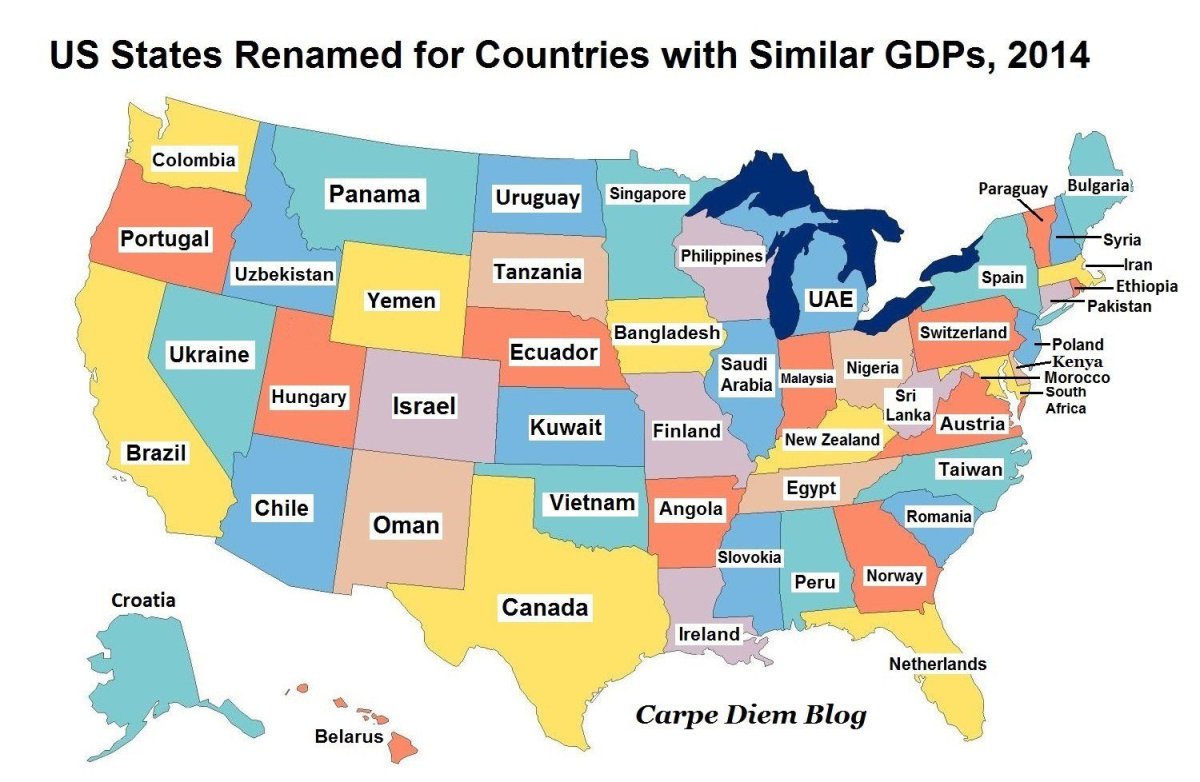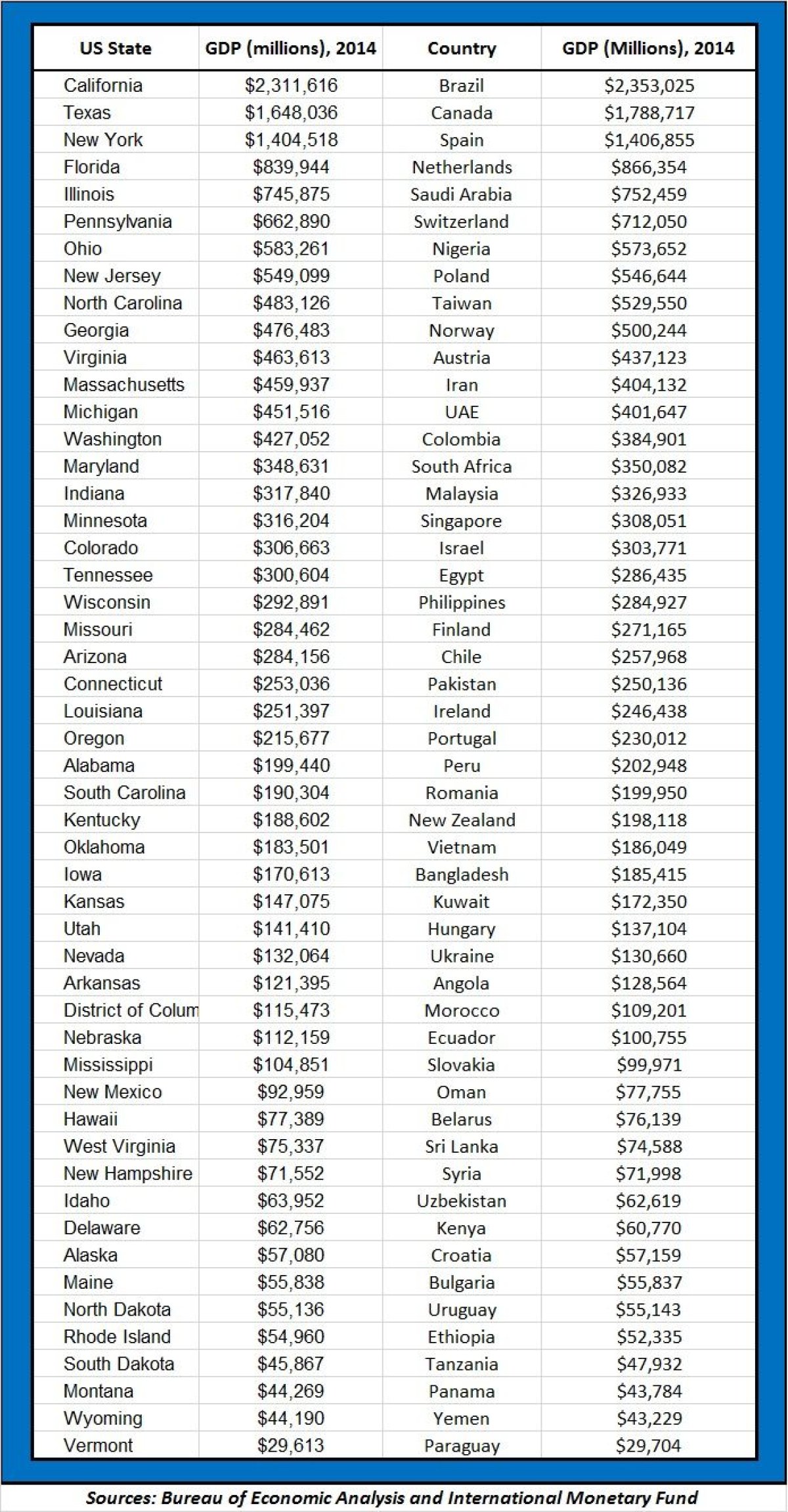
Following the Bureau of Economic Analysis (BEA) release on June 10 of U.S. state gross domestic product (GDP) data for 2014, I was able to update the map below, which appeared on the Carpe Diem blog a year ago using 2013 data.
The map was created by matching economic output in U.S. states in 2014 to foreign countries with comparable nominal GDPs, using BEA data for GDP by U.S. state and GDP by country from the International Monetary Fund, via Wikipedia here.
For each U.S. state (and the District of Columbia), I tried to find the country closest in economic size in 2014 (measured by nominal GDP), and for each state there was a country with a pretty close match—those countries are displayed in the map below and in the table below.
Obviously, in some cases the closest match was a country that produced slightly more, or slightly less, economic output in 2014 than a given U.S. state.

It's pretty amazing how ridiculously large the U.S. economy is, and the map above helps put America's GDP of nearly $18 trillion in 2014 into perspective by comparing the GDP of U.S. states to other country's entire national GDP. For example:
1. America's largest state economy is California, which produced $2.31 trillion of economic output in 2014, just slightly below Brazil's GDP in the same year of $2.35 trillion.
In 2014, California as a separate country would have been the eighth largest economy in the world, ahead of Italy ($2.1 trillion) and India ($2.04 trillion) and Russia ($1.86 trillion). And California's population is only 38.8 million compared to Brazil's population of 200.4 million, which means California produces the same economic output as Brazil with 81 percent fewer people. That's a testament to the superior, world-class productivity of the American worker.
2. America's second largest state economy—Texas—produced $1.65 trillion of economic output in 2014, placing it just slightly behind the world's 11th largest country by GDP—Canada—with $1.78 trillion of economic output.
3. Even with all of its oil wealth, Saudi Arabia's GDP in 2014 at $752 billion was just slightly more than the state GDP of Illinois ($746 billion).
4. America's third largest state—New York with a GDP in 2013 of $1.4 trillion—produced the same amount of economic output last year as Spain ($1.4 trillion), even though Spain's population of 47.3 million people is more than twice the number of people living in New York (19.75 million). Another example of the world-class productivity of the American workforce.
5. Other comparisons: Florida ($840 billion) produced about the same GDP in 2014 as the Netherlands ($866 billion), Pennsylvania ($663 billion) produces almost as much as the entire country of Switzerland ($712 billion) and Ohio ($583 billion) produces more than the entire country of Nigeria ($573 billion).
Perry: Overall, the U.S. produced 22.5 percent of world GDP in 2014, with only about 4.6 percent of the world's population. Three of America's states (California, Texas and New York)—as separate countries—would rank in the world's top 14 largest economies. And one of those states—California—produced more than $2 trillion in economic output in 2014—and the other two (Texas and New York) produced more than $1.6 trillion and $1.4 trillion of GDP in 2014 respectively.
The map and these statistics help remind us of the enormity of the economic powerhouse we live in. So let's not lose sight of how ridiculously large and powerful the U.S. economy is, and how much wealth and prosperity is being created all the time in the world's largest economic engine.

Note: Earl Fry, professor of political science at Brigham Young University, gets credit as the original creator of U.S. maps with states renamed for countries with similar GDPs (international doppelgangers of U.S. states). He has produced these maps on a regular basis since 2003.
Mark J. Perry is a scholar at the American Enterprise Institute and a professor of economics and finance at the University of Michigan's Flint campus. This article first appeared on the AEI site.
Uncommon Knowledge
Newsweek is committed to challenging conventional wisdom and finding connections in the search for common ground.
Newsweek is committed to challenging conventional wisdom and finding connections in the search for common ground.
About the writer
To read how Newsweek uses AI as a newsroom tool, Click here.








